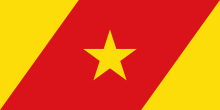Bibugn
Bibugn (Amharic: ቢቡኝ) is one of the woredas in the Amhara Region of Ethiopia. Part of the Misraq Gojjam Zone, Bibugn is bordered on the south by Sinan, on the west by Dega Damot woreda in the Mirab Gojjam Zone, on the northwest by Goncha, and on the east by Hulet Ej Enese. Towns in Bibugn include Digua Tsion, Weyin Wuha and Wabirr. Digo tsion (ድጎፅዮን) is the center of Bibugn wereda. There are over 15 kebelles in Bibugn wereda; among those, Debiresina is one of a kebelle that found in the north part.
Bibugn ቢቡኝ | |
|---|---|
Woreda | |
 Flag | |
| Zone | Misraq Gojjam |
| Region | Amhara Region |
| Area | |
| • Total | 399.79 km2 (154.36 sq mi) |
| Population (2012 est.)[1] | |
| • Total | 89,250 |
| • Density | 220/km2 (580/sq mi) |
History
In 2003 the opposition All Ethiopian Unity Party (AEUP) attempted to open a branch office in Bibugn. On 7 February, AEUP informed woreda officials of its plan and provided them a list of names of AEUP organizers, as requested. After receiving the list, woreda officials announced over a megaphone that people should neither associate with AEUP nor rent a house to AEUP members for its branch office. On 10 November of the same year, local kebele officials and militia set the home of an AEUP member on fire while he was asleep with his wife and child. While they were able to escape, they lost their house, livestock, and food.[2]
In October 2009, zonal officials announced that construction of 47-km road connecting Digua Tsion with Mota, with a budget of over 147 million Birr had begun, with completion expected by September 2010.[3] The construction completed in 2005 E.C that connected Bibugne with Motta and Bahirdar towns. The construction road creates good opportunities for travelers from Debremaekos to Motta towns in a short way.
Demographics
Based on the 2007 national census conducted by the Central Statistical Agency of Ethiopia (CSA), this woreda has a total population of 82,002, an increase of -1.48% over the 1994 census, of whom 40,190 are men and 41,812 women; 6,241 or 7.61% are urban inhabitants. With an area of 399.79 square kilometers, Bibugn has a population density of 205.11, which is greater than the Zone average of 153.8 persons per square kilometer. A total of 18,548 households were counted in this woreda, resulting in an average of 4.42 persons to a household, and 17,959 housing units. The majority of the inhabitants practiced Ethiopian Orthodox Christianity, with 99.13% reporting that as their religion.[4]
The 1994 national census reported a total population for this woreda of 83,231 in 17,448 households, of whom 41,345 were men and 41,886 were women; 1,763 or 2.12% of its population were urban dwellers. The largest ethnic group reported in Bibugn was the Amhara (99.9%). The majority of the inhabitants practiced Ethiopian Orthodox Christianity, with 99.56% reporting that as their religion.[5]
Notes
- Geohive: Ethiopia Archived 2012-08-05 at the Wayback Machine
- "Ethiopia: Country Reports on Human Rights Practices: 2003 report", Bureau of Democracy, Human Rights, and Labor, US State Department (accessed 9 July 2009)
- "Woreda constructing 47-km road", Ethiopian News Agency, 5 October 2009 (accessed 2 November 2009)
- Census 2007 Tables: Amhara Region Archived November 14, 2010, at the Wayback Machine, Tables 2.1, 2.4, 2.5, 3.1, 3.2 and 3.4.
- 1994 Population and Housing Census of Ethiopia: Results for Amhara Region, Vol. 1, part 1 Archived November 15, 2010, at the Wayback Machine, Tables 2.1, 2.7, 2.10, 2.13, Annex II.2 (accessed 9 April 2009)